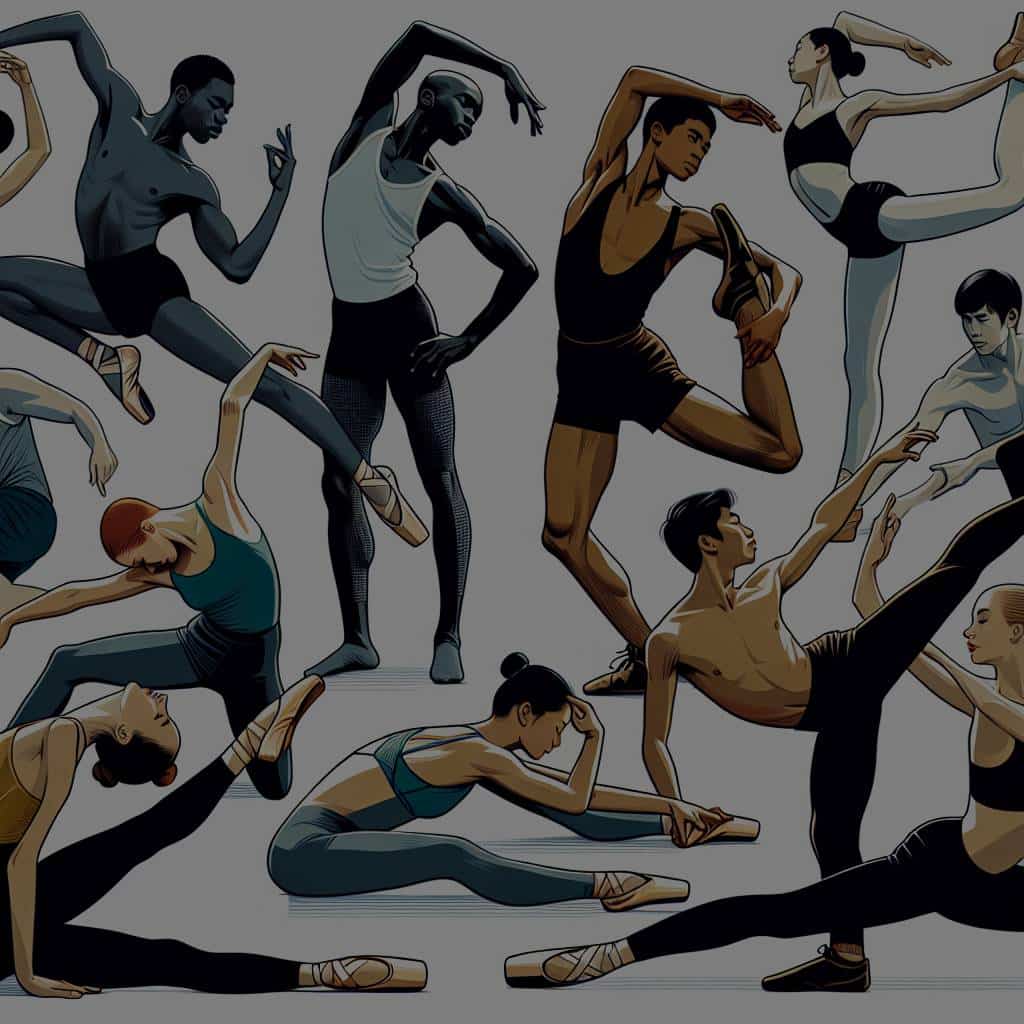How Can Dynamic Stretching Improve Flexibility in Ballet Dancers Who Play Sports?

In the world of dance, flexibility is not just a desired attribute – it’s a necessity. Whether you’re executing a grand jeté or a simple plié, the ability to move your body with ease and grace is paramount. For ballet dancers, especially those who also partake in sports, managing and enhancing their flexibility is a constant process. One proven method to achieve this is through dynamic stretching. By understanding the benefits of dynamic stretching and how it can enhance flexibility, dancers can improve their performance, reduce the risk of injury, and keep their bodies in peak condition.
The Importance of Flexibility in Dance and Sports
Before delving into the specifics of dynamic stretching, it’s important to understand why flexibility is so crucial for both dancers and athletes. In dance, flexibility allows for a greater range of motion, which in turn improves the quality of movements and choreography. In sports, flexibility facilitates swift and fluid body movements, reducing the risk of muscle strain or injury.
Also read : What’s the Role of Prehabilitation Exercises in Reducing Soccer Injuries?
Just as a musician must tune their instrument before a performance, dancers and athletes must prepare their bodies before they perform or compete. This involves warming up the muscles, and more often than not, stretching. However, not all stretches are created equal. The type of stretch you choose to incorporate into your training routine can have a significant impact on your flexibility and overall performance.
Understand Static versus Dynamic Stretching
When many people think of stretching, they probably envision static stretches – exercises in which you stretch a muscle to its fullest extent and then hold the position for a certain period. While static stretches can increase flexibility over time, they are not always the best choice for warming up before an athletic activity or dance.
In the same genre : Can Tailored Yoga Sequences Improve Flexibility in Martial Artists?
Dynamic stretching, on the other hand, involves active movements that stretch your muscles without holding a position. These stretches are performed in a controlled, smooth, and deliberate manner, and are designed to improve flexibility, muscle temperature, and body awareness. In contrast to static stretching, which can sometimes lead to muscle tightness or even injury when performed before rigorous activity, dynamic stretches are perfect for warming up the body safely and effectively.
The Benefits of Dynamic Stretching for Dancers
Dynamic stretching can help you achieve a greater range of motion in your joints and muscles, which is highly beneficial for ballet dancers. By practicing dynamic stretches, dancers can enhance their flexibility, improve their performance, and reduce their risk of pain and injury.
Dynamic stretches mimic the movements used in dance and sports, helping dancers warm up in a way that is specific to their activity. For instance, a dancer might perform leg swings to mimic the action of a grand battement, or arm circles to prepare for port de bras. These stretches not only warm up the muscles, but also help dancers reinforce the proper technique and body alignment.
Another benefit is that dynamic stretches can be adjusted to target specific muscles or muscle groups. For instance, if a ballet dancer also plays soccer, they could incorporate dynamic stretches that target both the muscles used in dance (such as the hip flexors and hamstrings) and those used in soccer (like the quadriceps and calves).
Incorporating Dynamic Stretching into Your Training
When incorporating dynamic stretching into your routine, it’s crucial to perform each stretch correctly to avoid injury. Begin each stretch slowly and gradually increase the speed and range of motion. As you stretch, focus on maintaining correct body alignment and control. Remember that the goal is to warm up your muscles, not to force them into an extreme range of motion.
Here are some examples of dynamic stretches that are beneficial for ballet dancers:
- Leg swings: Stand next to a barre or wall for support, and swing one leg forward and backward in a controlled manner. Repeat on the other leg.
- Lunge with a twist: Step forward into a lunge, then twist your upper body towards the lunged leg. Repeat on the other side.
- Arm circles: Extend your arms out to the sides and make small circles with your arms, first forward, then backward.
Before starting any new type of exercise regimen, it’s always a good idea to consult with a professional to ensure you’re performing each stretch correctly.
In conclusion, dynamic stretching is an excellent tool for ballet dancers who also play sports. By incorporating these stretches into your training routine, you can improve your flexibility, enhance your performance, and protect your body from injury. So why not give dynamic stretching a try? Your body – and your dance technique – will thank you.
The Science Behind Dynamic Stretching
It’s well-documented in the world of sports medicine that dynamic stretching can effectively enhance a dancer’s range of motion. Dynamic stretches require the body to move fluidly through a specific range of motion repeatedly. This type of stretch can significantly improve flexibility, and a study in the Journal of Strength and Conditioning Research has solidified this claim with scientific evidence.
Dynamic stretching works by repeatedly moving parts of your body to gradually increase reach and speed. This practice is quite different from static stretches, where you stretch a muscle to the point of slight discomfort and hold it for a period. However, the problem with static stretching is that it can sometimes lead to muscle tightness or even injury when performed before rigorous activity. On the contrary, dynamic stretches are perfect for warming up the body safely and effectively.
Also, you should note that dynamic stretching isn’t the same as ballistic stretching. Ballistic stretching involves bouncing movements to push your body beyond its normal range of motion, potentially leading to injury. Dynamic stretching is controlled and smooth, designed to warm up your muscles and improve flexibility without causing strain.
The acute effects of dynamic stretching include increased heart rate, improved balance, and enhanced muscle performance. By incorporating dynamic stretching into your routine, dancers can optimize their performance and reduce their risk of injury, furthering the findings of Medicine and Science in Sports and Exercise Journal.
Conclusion: Flexibility and Beyond
In the interconnected worlds of dance and sports, dynamic stretching stands out as an invaluable tool for enhancing flexibility and performance. This form of stretching, backed by sports science and physical therapy principles, not only enhances flexibility but also prepares the body for the movements it will perform.
Dynamic stretching helps you achieve a greater range of motion in your joints and muscles, which is critical for ballet dancers and athletes alike. It mimics the movements used in dance and sports, helping dancers warm up in a way tailored to their activity. Whether you’re gearing up for a grand jeté or a sprint down the soccer field, dynamic stretching can prepare your muscles and joints for the task ahead.
Another noteworthy advantage is the adaptability of dynamic stretches. They can be adjusted to target specific muscles or muscle groups, catering to your unique needs as a dancer and athlete. From strengthening your hip flexors for a grand battement to enhancing your quadriceps for a powerful kick in soccer, dynamic stretching serves multi-sport athletes effectively.
However, as effective and beneficial as dynamic stretching is, it’s crucial to perform each stretch correctly and safely. Initiating each stretch slowly, gradually increasing the speed and range of motion, and focusing on maintaining correct body alignment and control are key to reaping the maximum benefits from dynamic stretching and minimizing the risk of injury.
In conclusion, dynamic stretching is a powerful, adaptable, and proven tool for enhancing flexibility, improving performance, and reducing injury risk in ballet dancers who also partake in sports. So, give dynamic stretching a go in your next warm-up routine, and you’ll likely find your performance reaching new heights. Your body, your dance technique, and your sports performance will thank you.
